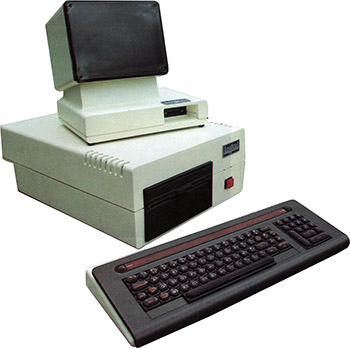
The David is not the first computer released by Logical Business Machines. In 1974, LOMAC (Logical Machine Corporation) released the Adam. Some times later they also produced Tina (for TINy Adam). There was also the Goliath, a data storage server with 5MB hard drive. Goliath could be connected to up to 20 Davids or Tinas. David and Goliath names makes a clear reference to the mythical story found in the biblical Book of Samuel.
The David is powered by a 16-bit Intel 8086 CPU with 64KB RAM, and equipped with a 8'' dual sided double density floppy drive unit (1,25MB capacity). The video display unit shows 24 lines of 80 characters each, and an upper and lower case character set with descenders. David’s printer also features upper and lower case in a 7 x 7 matrix. Type size variance allows 40, 66, 80 and 132-column format in eight inches because character pitches of 5, 8.25, 10 and 16 can be selected within a program. Optional wider carriage and faster printers were also provided.
The computer itself was available in two cosmetic models: one with a detachable keyboard (pictured here) and another where display unit and keyboard are put into a monobloc case (see pictures section). There are two RS232C and one parallel connector. It's also possible to connect a second display, which is independent. You can edit programs on one and display the results on the second display.
But the most original feature of the David is not its hardware or cosmetic details, it is its operating system and language !
Logical Business Machines was an american company based in Sunnyvale, California. It was founded by John Peers, prior to creating ‘The Byte Shop’, one of the first successful chains of personal computer stores. His studies in human learning in the 70s led him to a neurological emulations approach in computing, now better-known as neural networking technology. In 1982, Mr. Peers also founded Novix, Inc., specializing in the design of high-speed microprocessors and software optimized for neural and massive parallel computing. John McAfee was vice President of engineering at Logical (at least in 1983/1984).
This historical background is necessary to explain why the David computer was so special. The philosophy behind the David and its operating system/language called ALP, is that the user is not necessarily a computer expert. Thus the system let the user create its own language based on verbs, words, nouns, numbers or expressions. Verbs call actions for example and can be used to create and index files, manipulate data, prompts the user to enter data, while nouns represent the user's data. Thus the user communicate with the computer via a "natural" language conceived by the user itself. It's the difficult to explain how it works, but the concept was revolutionary at the time. This natural language was the predecessor of PRAGMA (that is still used today).
Sadly, these computers and their concept didn't sell well and very little is known about them. Any testimonies or memories are welcome !
In 1983, Logical released another computer: the L-XT which was based on the same natural language concept but also MS-DOS compatible.
|









